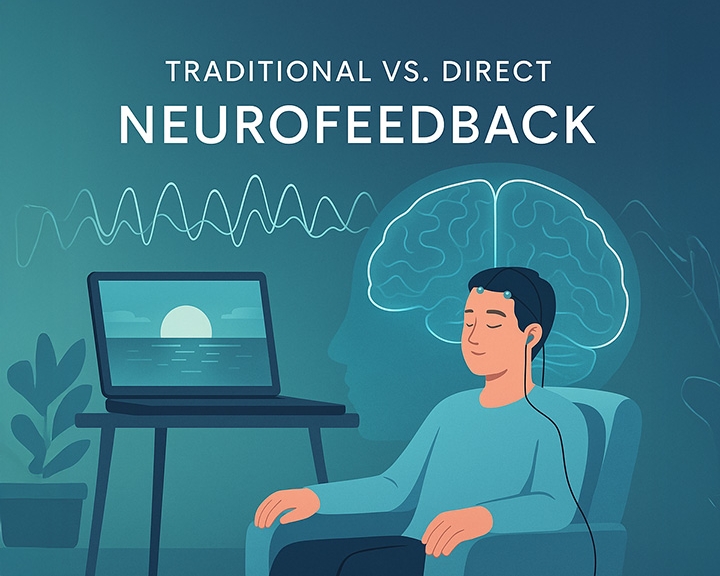
Understanding the Difference Between Traditional Neurofeedback and Direct Neurofeedback
Explore two innovative, drug-free ADHD treatment options—and learn which might be right for you or your child
Neurofeedback is a non-invasive, evidence-based treatment that helps retrain brainwave activity to improve attention, focus, mood, and emotional regulation. While all neurofeedback techniques involve monitoring brain activity using sensors on the scalp, the way feedback is delivered can vary significantly. The two most common approaches are Traditional Neurofeedback and Direct Neurofeedback.
Although both methods aim to improve brain function, they work in fundamentally different ways. Understanding these differences can help you decide which approach is a better fit for your goals, your lifestyle, or your child’s needs—especially if you’re looking for a drug-free ADHD treatment option.
What Is Traditional Neurofeedback?
Traditional neurofeedback—also known as EEG biofeedback—uses real-time displays of brainwave activity to help individuals learn how to regulate their own brain function. During a session:
- Sensors are placed on the scalp to record brainwave patterns.
- This activity is transmitted to a computer that presents visual or audio feedback, often through games or movies.
- The patient interacts with the feedback, learning to produce more balanced brainwave activity over time.
This process is interactive, like a form of mental exercise or brain training. Over multiple sessions, the brain learns to self-correct patterns associated with inattention, anxiety, impulsivity, or sleep difficulties.
Who It’s For
Traditional neurofeedback is ideal for individuals who enjoy an interactive process and are willing to commit to regular sessions over time. It’s often used for:
- Children and teens with ADHD or learning challenges
- Adults managing anxiety, depression, or sleep issues
- Patients who may not be candidates for direct neurofeedback (e.g., due to migraines or pacemakers)
What Is Direct Neurofeedback?
Direct neurofeedback uses a more passive, yet powerful approach. Like traditional neurofeedback, sensors are placed on the scalp to read brain activity. However, instead of using visual or audio feedback:
- A very tiny, imperceptible electrical signal is sent back to the brain.
- This signal disrupts stuck or dysregulated patterns, allowing the brain to reorganize itself.
- There’s no conscious effort required from the patient—just sit back and relax.
This method doesn't stimulate or suppress brain activity directly. Instead, it gently nudges the brain toward a more balanced state.
Who It’s For
Direct neurofeedback is often a good fit for people who want faster results with less effort. It is:
- Passive and non-interactive (ideal for those with attention challenges)
- Time-efficient (sessions typically last about 30 minutes)
- Known for rapid improvement—even in clients who didn’t respond to traditional neurofeedback
Key Differences at a Glance
| Feature | Traditional Neurofeedback | Direct Neurofeedback |
|---|---|---|
| Type of Feedback | Visual/audio interaction | Subtle electrical signal |
| Client Involvement | Active participation required | Passive (no effort required) |
| Session Length | 45–60 minutes | ~30 minutes |
| Typical Time to Results | Gradual over 15–40 sessions | Often noticeable in 1–4 sessions |
| Best For | Learning-based brain training | Quickly calming dysregulated states |
| Not Recommended For | N/A | Chronic fatigue, migraines, pacemakers |
Which Neurofeedback Option Is Right for You?
Choosing between traditional and direct neurofeedback depends on your goals, sensitivities, and preferences. Here are some questions to help guide your decision:
- Are you or your child open to an interactive, gradual training process? → Consider Traditional Neurofeedback
- Are you seeking faster relief from anxiety, ADHD, or emotional dysregulation? → Direct Neurofeedback may be the better fit
- Have other treatments failed to produce lasting change? → Direct Neurofeedback may offer a breakthrough
- Do you have a history of migraines or sensitive medical conditions? → Traditional Neurofeedback may be safer
Why Families Choose Neurofeedback as a Drug-Free ADHD Treatment
Many families are searching for natural, non-medication options to manage ADHD and related conditions. Neurofeedback offers a compelling, research-supported alternative—especially for those who are concerned about side effects, dependency, or long-term use of stimulant medications.
At the Center for Attention Deficit and Learning Disorders, we offer both traditional and direct neurofeedback in Scottsdale, Arizona. Our team helps patients—both children and adults—discover which treatment is best suited to their brain and their life.
Want Help Deciding?
Whether you're exploring neurofeedback in Scottsdale for your child or yourself, we’re here to guide you. Our clinicians take a personalized approach, helping you make a choice that supports your goals—without pressure and without defaulting to medication.
Schedule a free consultation to learn more about your options and start moving toward lasting change.